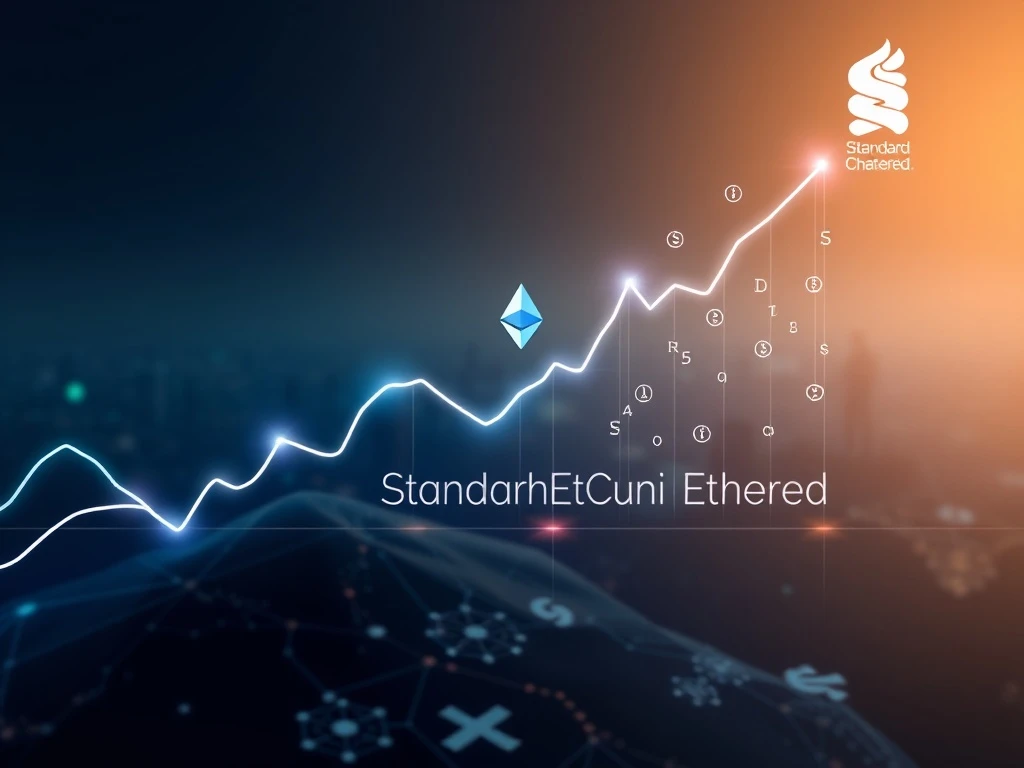Ethereum Price Target Soars: Standard Chartered Unleashes Bold $7.5K ETH Forecast for 2025

Cryptocurrency markets are buzzing with renewed optimism. Standard Chartered, a major financial institution, recently unveiled a significantly higher Ethereum price target for 2025. This bold prediction now stands at $7,500, a substantial increase from its earlier $4,000 forecast. This upward revision underscores a growing confidence in Ethereum’s fundamental strength and market potential, particularly among institutional players. Investors are keenly watching these developments, as they signal a potentially bullish future for the second-largest cryptocurrency by market capitalization.
Unpacking Standard Chartered’s Optimistic ETH Forecast
Standard Chartered’s revised ETH forecast reflects several pivotal shifts in the crypto landscape. A report shared with Crypto News Insights detailed the bank’s reasoning. Notably, institutional engagement has intensified significantly since March. This includes substantial activity from key ecosystem organizations like the Ethereum Foundation and Etherialize. Such strong industry participation provides a solid foundation for future growth. Furthermore, the report highlights record-breaking institutional accumulation of Ether, signaling robust demand.
The bank observed a rapid accumulation of Ether by treasury companies and exchange-traded funds (ETFs). These entities acquired 3.8% of all circulating ETH since early June. This rate nearly doubles the fastest Bitcoin accumulation seen during the 2024 US election cycle by similar investment vehicles. Consequently, this strong institutional buying pressure significantly impacts market dynamics. This unprecedented demand underscores the growing acceptance of crypto assets within traditional finance, particularly concerning Standard Chartered ETH analysis.
The Surge in Ethereum ETFs and Institutional Adoption
The emergence and growing interest in Ethereum ETFs represent a major catalyst for ETH’s price appreciation. These investment products provide traditional investors with regulated access to Ethereum exposure. Their rapid adoption indicates a broader institutional embrace of digital assets. Moreover, treasury companies are increasingly adding ETH to their balance sheets. This trend reflects a strategic move to diversify portfolios and capitalize on Ethereum’s perceived long-term value. The combined effect of ETF inflows and corporate treasury accumulation creates powerful upward price momentum for Ether.
This institutional accumulation provides strong validation for Ethereum’s ecosystem. It also enhances market liquidity and stability. As more traditional financial players enter the market, Ethereum gains further legitimacy. This increased participation can also attract retail investors, creating a virtuous cycle of demand. Therefore, the role of institutional capital cannot be overstated in driving Ethereum’s current and future valuations.
Stablecoin Market Cap Expansion and the GENIUS Act’s Impact
The recent passage of the GENIUS Act in July stands out as another critical factor influencing Ethereum’s outlook. This legislation provides a clear regulatory framework for stablecoins in the United States. It consequently paves the way for their broader mainstream adoption. Stablecoins already constitute 40% of all blockchain fees. Over half of these are issued directly on the Ethereum network. This dominance highlights Ethereum’s pivotal role in the burgeoning stablecoin economy.
Standard Chartered projects the global stablecoin market cap to expand eightfold, reaching an impressive $2 trillion by 2028. This projected growth will directly and indirectly drive demand for Ethereum. Decentralized finance (DeFi) protocols heavily rely on stablecoins. Ethereum currently commands a 65% share of total value locked (TVL) within the DeFi sector. Therefore, stablecoin growth inherently fuels Ethereum’s utility and value. The GENIUS Act’s clarity will likely accelerate this expansion, further solidifying Ethereum’s position as the leading platform for digital currency innovation.
Ethereum’s Network Upgrades and Long-Term Trajectory
Ethereum’s ongoing technical advancements also bolster its bullish outlook. Vitalik Buterin, Ethereum’s co-founder, outlined plans to boost the network’s Layer 1 throughput by tenfold. This significant upgrade will enable more high-value transactions to settle directly on the main blockchain. Smaller transfers, however, will increasingly rely on Layer 2 scaling solutions like Arbitrum and Base. This layered approach enhances scalability and efficiency, addressing historical network congestion concerns.
Standard Chartered anticipates ETH will surpass its previous all-time high of $4,866 by the end of Q3 2025. This prediction suggests continued outperformance against Bitcoin. The bank projects the ETH-BTC ratio will climb from 0.036 to 0.05. This shift reflects strengthening Ethereum fundamentals relative to Bitcoin. At the time of writing, ETH trades near $4,692, less than 4% shy of its November 2021 peak of $4,891, according to CoinMarketCap data. Furthermore, Standard Chartered’s long-term outlook sets even higher targets: $12,000 in 2026, $18,000 in 2027, and a remarkable $25,000 by 2028. These projections paint a very optimistic picture for Ethereum’s future.
Navigating Profit-Taking as ETH Approaches All-Time Highs
As Ether nears a new all-time high, natural market dynamics, including profit-taking, are emerging. The Ethereum whale collective known as “7 Siblings” recently sold $88.2 million worth of ETH. This involved unloading 19,461 ETH at an average price of $4,532 over a single day. Similarly, the Ethereum Foundation sold 2,795 ETH, totaling approximately $12.7 million, in two transactions. These actions represent typical market behavior as investors secure gains near significant price levels. Such profit-taking is a healthy part of market cycles, often preceding further consolidation or upward movement after short-term corrections. It does not diminish the long-term bullish sentiment highlighted by Standard Chartered’s comprehensive analysis.










